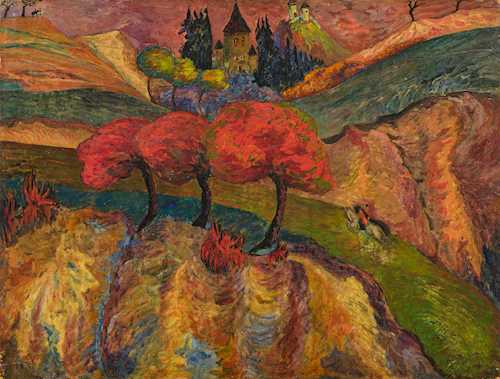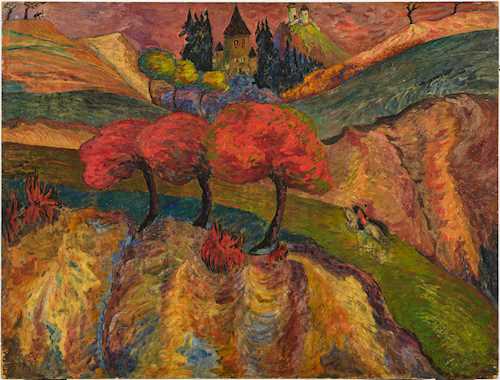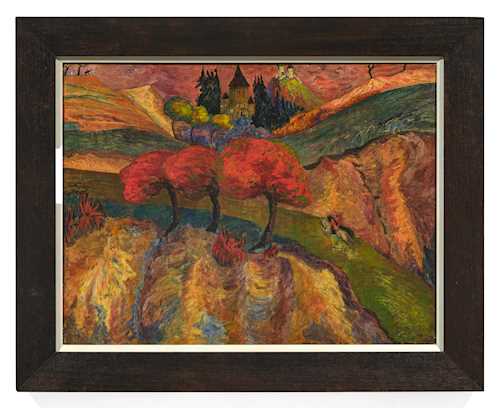
Lot 3235 - A209 Art Impressionniste & Moderne - vendredi, 21. juin 2024, 17h00
MARIANNE VON WEREFKIN
Provenance:
- Bühler collection, Landhaus Waldbühl, Uzwil, acquired on 20.12.1972 from the above gallery.
(Werefkin, November 18, 1928, in: Fäthke, Munich 2001, p. 188).
When the First World War broke out in 1914, Werefkin and Jawlensky fled to Switzerland, where they initially settled in St. Prex. The present work was probably created in this small community on Lake Geneva. Werefkin, as an important member of the Blue Rider group, is at the same time oriented towards Symbolist painting and is inspired by the colorful works of Gauguin, the Nabis, van Gogh, Edvard Munch and Ferdinand Hodler.
The work coming to auction is an excellent example of Werefkin's unique understanding of art and combines various biographical and artistic elements. As a refugee in St. Prex, which served as only a temporary haven, he lived together with Jawlensky, two maids and Jawlensky's child (whose mother was one of the maids), in an unusually small apartment. With a pension halved due to the war and Jawlensky complaining about the overall situation, the period must have been difficult for Werefkin. She conveys the pervasive mood and calamity of war in her paintings of this time in a fantastically striking way.
In "Romantic Landscape with Riders" Werefkin succeeds in constructing a kind of oxymoron – an apocalyptic fairytale world in which both the dark and the joyful find space. The atmospheric hilly landscape is lined with trees and at the center sits a fairytale castle in the far distance. It impresses, among other things, with its high-contrast colors that are applied in a vibrant manner to the wooden background. The decision to use non-naturalistic colors reflects the shared desire of Werefkin and other symbolists to free color from its purely descriptive function in painting. Instead, the goal is to merge the external world with the artist's subjective perception. In this way, Werefkin deepens the personal, human connection that permeates her work.
Particularly notable and characteristic of the artist is the choice of a twisted perspective strongly reminiscent of Edvard Munch's paintings. The curved color areas that all flow into the middle reinforce the feeling of being swallowed up by the landscape.
One special detail that offers possibilities for interpretation is the depiction of two riders in the picture. The rider, as the principal symbol of the "Blue Rider" artist group, stands for freedom per se. It represents constant movement and the search for new artistic forms of expression. Two pairs of riders can be seen in the work. The small pair of riders at the top left, standing on the highest hill, are at the beginning of their journey. The second couple, possibly the very same but shown in the future, gallop on their horses down the street towards the castle, not knowing how long the journey will take. Whether it is Werefkin and Jawlensky themselves, who are always restlessly looking for new artistic stimulation despite difficult circumstances, or perhaps the four horsemen of the apocalypse who announce the end of the world, is up to the viewer.
REITER VOR DER EWIGKEIT
ROMANTISCHE LANDSCHAFT MIT REITERN: MARIANNE VON WEREFKIN
Jara Koller präsentiert eines ihrer Lieblingswerke in der Auktion, eine Landschaft mit Reitern von Marianne von Werefkin.
CHF 100 000 / 150 000 | (€ 103 090 / 154 640)
Vendu pour CHF 475 000 (frais inclus)
Aucune responsabilité n'est prise quant à l´exactitude de ces informations.



